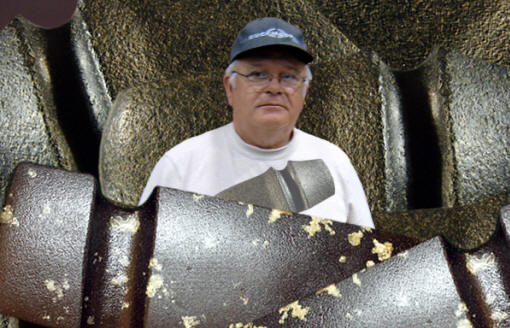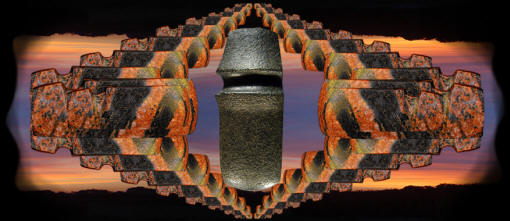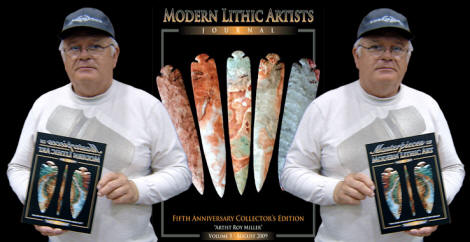|
"My favorite
axe types have always been those found in the Midwest."-------2011,
Tom Onken.
"I basically make two types of axes (art
axe and authentic reproduction axe)
and they differ in part by the material they are made from and the
manner in which they are finished."--------2011,
Tom Onken.

AXES
BY TOM ONKEN
MODERN-MADE
Tom Onken's skill as a maker of stone axes is well known. He
represents a small group of lithic artists who are replicating ground
stone artifacts. Most of today's lithic artists are replicating flaked
stone artifacts. Tom says he's developed his own technique for making
axes and can now accurately replicate any of the more complex axe forms
from the Midwest area.
|
|
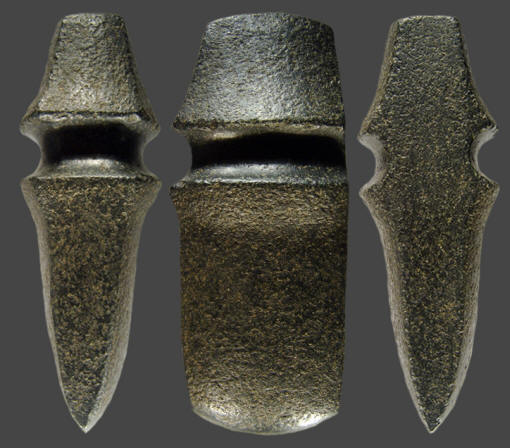
CLICK ON PICTURE FOR LARGER IMAGE
A TOM ONKEN RAISED RIDGE AXE
"AUTHENTIC REPRODUCTION"
BLACK GRANITE
This axe was made by Tom Onken. These three views show an example of
what Tom calls an "authentic reproduction" of a raised ridge axe.
This type of axe takes considerably longer to make because so much
more of the stone has to be removed in order to form the ridges. An
ancient axe, similar to this one and measuring 10 inches (25.3 cm)
long, could have taken several hundred hours to make. Tom says he
likes to use glacial cobbles to make his axes, rather than water
worn pebbles. This piece of black granite was first cut and ground
into shape with modern power tools. Then an old traditional pecked
surface was applied with a flint hammer stone. The last step
involves smoothing and polishing on different areas of the axe. The cutting edge and the inside of the groove has
the smoothest surface. This axe was a gift to Tom's father Ed
several years ago. It's made of black granite and measures 9 1/8
inches (23.2 cm) long, 3 11/16 inches (9.4 cm) wide and 3 3/16
inches (8.1 cm) thick. |
|
|
Tom Onken began
making axes in 1990. He was influenced by his father Ed who was a
serious collector of prehistoric Indian artifacts beginning in the
1960's. In later years his father expressed an interest in modern axes
and points. Since Tom was already interested in stone artifacts it was
at this time that he started his first attempts to make stone axes. |
|
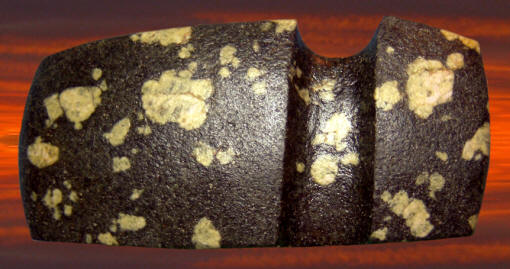
IOWA STYLE SLANT GROOVE
AXE
A TOM ONKEN "AUTHENTIC REPRODUCTION"
PORPHYRY
Tom considers this "authentic reproduction" of an
Iowa style slant groove axe the best one of this type that he has
made so far. One of the most obvious reasons that it's one of his
favorites is the nice color pattern of the porphyry stone that it
was made from. This axe measures about 5 inches (12.7 cm) long. |
|
|
Tom is 100% self taught in the area of axe production. He
says that the techniques that he developed over the years has served him
well. As he became more skilled in the art of making axes his dad
proudly displayed many of them on the mantel over the fireplace. When
collecting buddies came to the house for a visit, many of them were sold. |
|
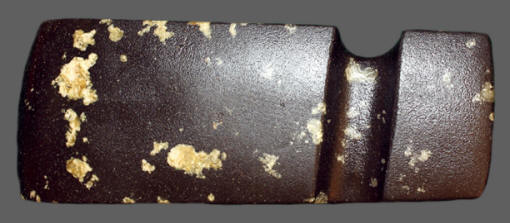
IOWA STYLE SLANT GROOVED
AXES
A TOM ONKEN "ART AXE"
PORPHYRY
This Iowa style slant
groove axe was made this year (2011) by Tom Onken. It's a good
example of what he calls his "art axe" type. These axes aren't made
to look exactly like an ancient axe. In fact, some of them may be
made of less durable stones that were not necessarily used by
ancient axe makers but they are more colorful. The idea is to make them
as pretty to look at as possible. These "art axes" have a high surface polish
with no hand pecking. |
|
|
Tom's favorite axe
types have always been those found in the Midwest. They include
Illinois, Iowa and Missouri type axes. He especially likes the Iowa
slant groove and raised ridge axes. He
produces these axes in two different categories, as either an "art axe" or an "authentic reproduction
axe." |
|
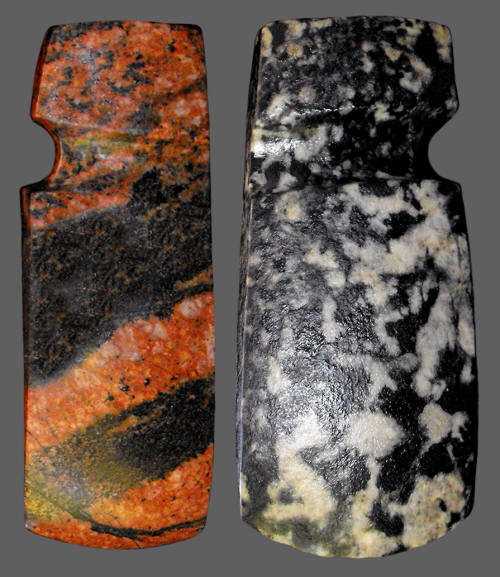
IOWA STYLE SLANT GROOVED
AXES
TOM ONKEN "ART AXES"
GRANITE AND PORPHYRY
Both of these beautiful axes were made by Tom Onken. They were
published in 2005 in the first issue of the "Modern Lithic Artists"
journal. Both of them are Iowa slant groove style axes which
is one of Tom's favorite axe types. The axe on the right is made of
a beautiful piece of porphyry stone and the one on the left is made
of a colorful piece of granite. Both axes have a high surface
polish. |
|
|
Tom's "art axes" are made from materials that may not have been
traditionally used by ancient axe makers. Because they are generally
made from more "exotic" and highly colorful stones. He has made some of
them out of banded slate and "puddin stone" (conglomerate) which
are stones that may not be very efficient wood chopping tools. Tom's "Art axes" also have a very high polish surface finish with
no hand pecking. |
|
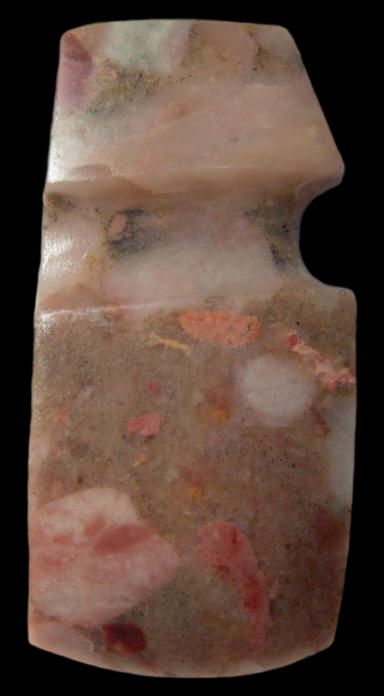
RAISED RIDGE
AXE
A TOM ONKEN "ART AXE"
"PUDDIN STONE" CONGLOMERATE
This axe was made from a nice
colorful piece of "puddin stone" conglomerate. It's made in the
style of a raised ridge axe and it has a high polish surface with no
hand pecking. |
|
|
Tom's "authentic reproduction" axes are high grade axes that
are usually the choice of serious collectors. Tom explains them as
being, "made correctly from the stones of choice by prehistoric man.
They may also exhibit exceptional color and have the highest degree of
workmanship. They are also hand pecked in the finishing process after I
have used my diamond tools to make the axe." Tom says that he believes
that some of the most skillfully made old axes would have taken hundreds
of hours to make, especially if the hand pecked surface was ground and
polished away. |
|
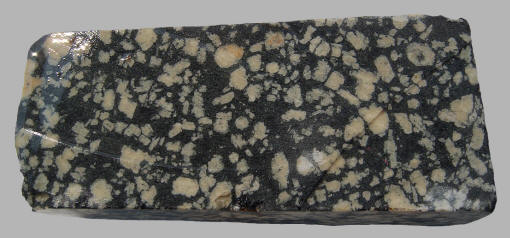
MODERN AXE BLANK
AXE PREFORM CUT BY TOM ONKEN
PORPHYRY
This picture shows a beautiful piece of porphyry stone that was sawn
by Tom Onken into a rectangular shape called a blank. The next step
will be to draw an outline of the proposed axe on the different
surfaces of the stone. Then the stone would be ground into shape with
angle and die grinders. Other diamond tools may also be used in the
process. If the axe is to be an "authentic reproduction" the surface
will be hand pecked with flint hammer stones then polished to
various levels on different areas of the axe. The edge of the bit
and the inside of the groove will usually have more polish than
other surface areas. If this axe is to be made into an "art axe" the
surface will receive a high polish with no hand pecking. |
|
|
There is no doubt that Tom Onken is one of the best axe
making craftsmen living today. Four of his axes are published in the
first issue of the "Modern Lithic Artists" journal. Tom says he's
starting to make a few more of
his finer axes this year after taking a break since he began the Lithic
Artists Guild in 2004. If you would like to acquire one of his axes you
can contact him at his web site
www.lithicartistsguild.com. |
|
"REFERENCES"
Personal Communications with Tom Onken.
|
|
RECENT
LISTINGS HOME
ORDERING |
